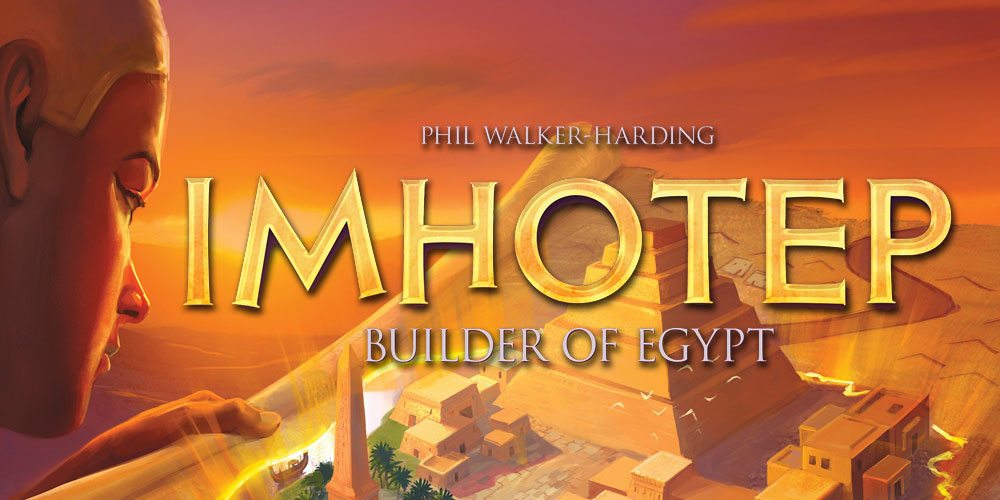Imhotep was the legendary architect of the Egyptian monuments, but he was also ruthless and brutal. In this Spiel des Jahres–nominated game, you take on the role of architects, competing to build monuments according to your design and to claim the most glory.
At a glance: Imhotep is for 2 to 4 players, ages 10 and up, and takes about 40 minutes to play. It retails for $39.95 and is available in retail stores and from Amazon. The game is not too difficult to teach, but there can be pretty cutthroat competition between players, so I think 8 to 10 is the minimum age, depending on your kids’ level of comfort with that, and it’s also a great game for adult players.
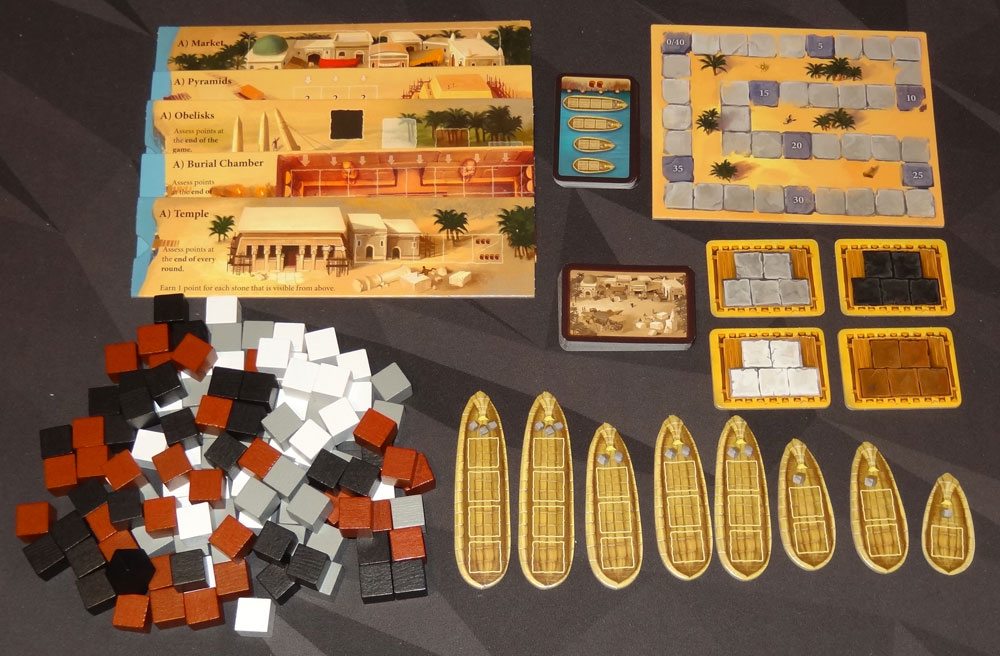
Components
- 5 Site boards
- 120 wooden blocks (30 each in 4 colors)
- 1 Scoring Track board
- 8 Ship tokens
- 4 Supply Sled tokens (1 in each color)
- 21 Round cards
- 34 Market cards
The wooden cubes (which represent giant stone blocks) are impressive—they’re the size of standard dice, so quite a bit larger than a lot of the wooden resource cubes you see in many games. In a game about building Egyptian monuments, that’s appropriate: the pyramids and obelisks and walls have a big presence on the table because of the size of the cubes.
The ship tokens have spots for 1 to 4 of the cubes, along with a little indication on the front of the ship of the minimum number of stones required to launch that ship.
The site boards have a notch in one side where the ships fit, to represent the ship landing at that site to unload stone blocks. Each of the site boards has some instructions on how it works and most (except for the Market) have spaces for the cubes. Each site board is also double-sided, with an “A” side and a “B” side, so that you can mix up the game and get a slightly different feel each time you play.
The cards are all half-sized cards: the round cards track which round it is and what ship will be available for the round, and the market cards are various special cards that can be claimed from the Market site.
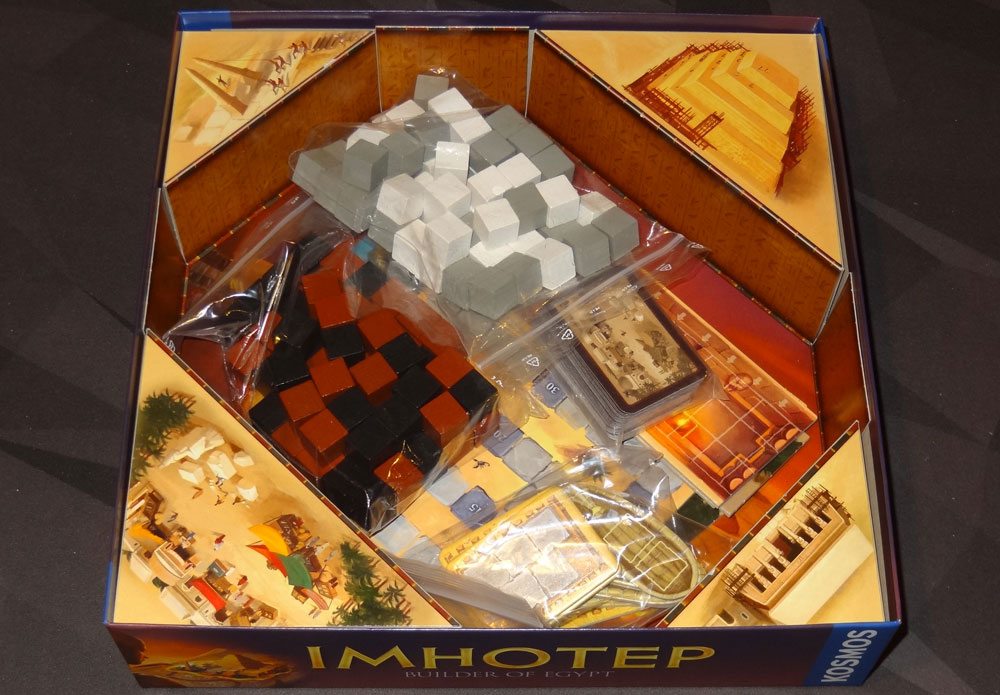
Overall, the component quality is very nice: the blocks are fun, the cardboard components are sturdy and punch out cleanly, and the illustrations add to the theme without interfering with gameplay and legibility. My only complaint is the box size, which is larger than it needs to be, as you can see from the photo above. There’s a strange diagonal insert to take up some of the space in the box, but, even so, the storage space is at least half empty.
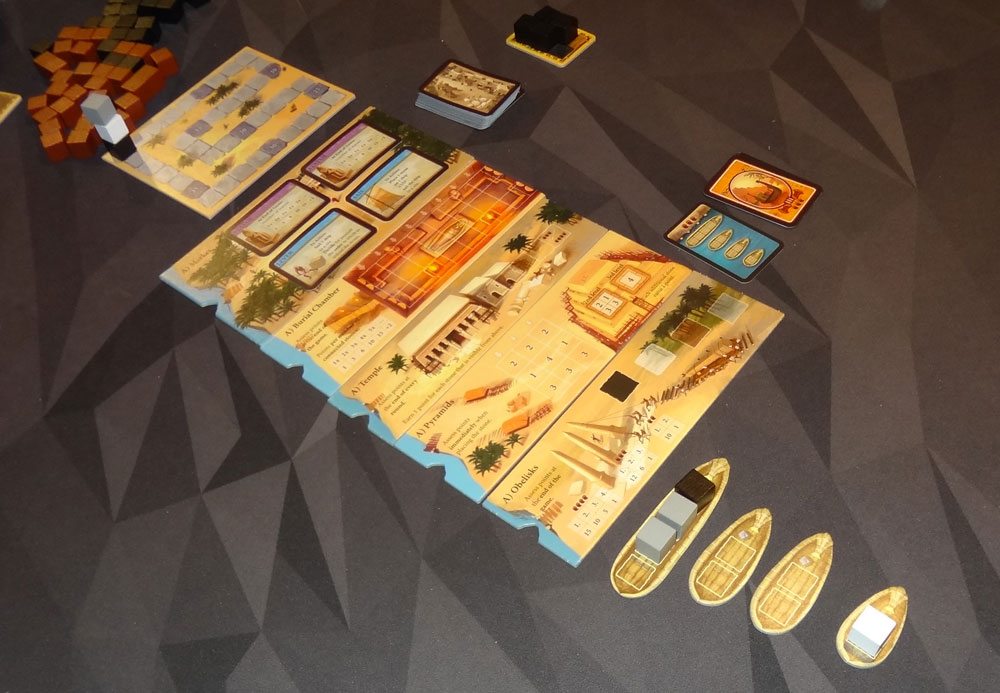
How to Play
The goal of the game is to score the most points in 6 rounds by getting your stones to the right places in various monuments.
To set up, put the 5 site boards in the center of the table—for the first game, use all “A” sides, but you can mix them up in future games. Put the scoring track and the ships to one side, and pile all of the blocks in one area as the stone quarry. (Note: it’s a good idea to place the quarry in the middle rather than give each player a pile of their blocks, because, otherwise, it is too easy to play blocks directly from the supply rather than from the supply sleds.)
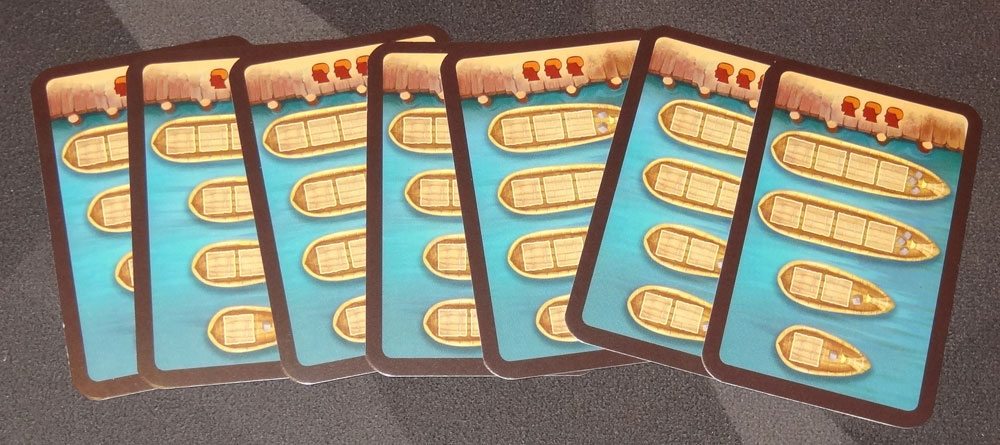
Find the round cards for your number of players—there are three sets, for 2-player, 3-player, and 4-player games. Shuffle the set of seven, and then remove one without looking at it. The remaining six cards will track the six rounds of play.
Each player chooses a color and takes the supply sled token of that color. The first player takes 2 stones of their color and places it on their supply sled, the second gets 3 stones, the third player gets 4 stones, and the fourth player gets 5 stones. In addition, each player puts a stone of their color on the start of the scoring track.
To start a round, flip over the next round card, and find the ships pictured on the card and place them in the center playing area, and set the other ships aside.
On your turn, you may take one action:
- Get new stones
- Load 1 stone
- Sail 1 ship
- Play 1 blue market card
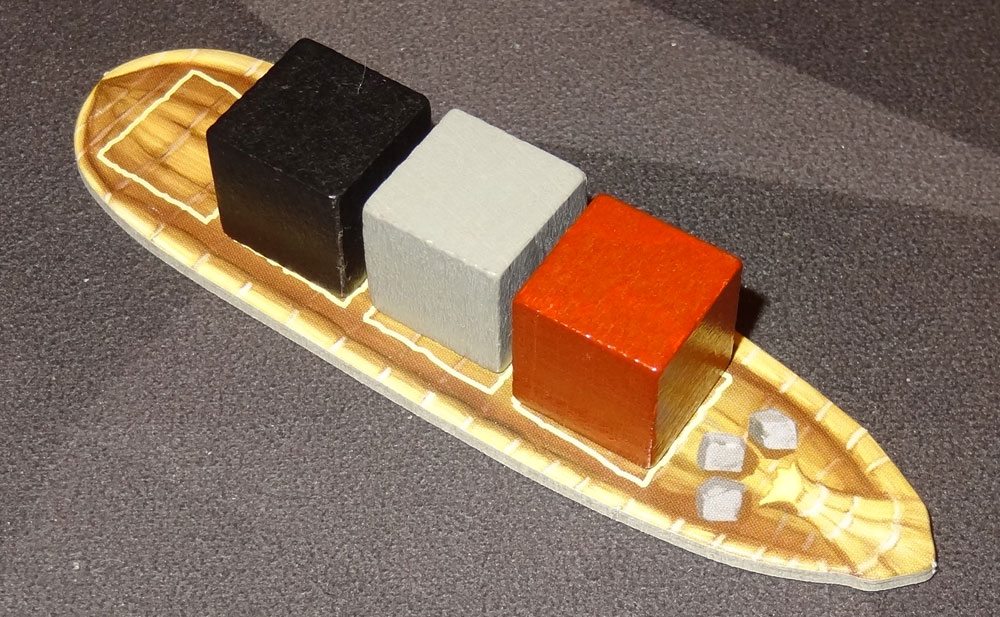
Get new stones: Take up to 3 stones from the quarry and put them on your sled. (You may only hold up to 5 stones on your sled.) You may not take this action if you already have 5 stones, or if there are no more stones of your color in the quarry.
Load 1 stone: Place 1 stone from your sled onto any empty space on a ship that hasn’t sailed yet.

Sail 1 ship: Choose a ship and sail it to a site board. The ship must have at least the minimum number of stones (indicated by the little gray stone symbols at the front), and you must sail it to a site that has an open dock. Once there, the stones are unloaded from front to back onto the site, placed according to the site’s instructions.
Play 1 blue market card: The blue market cards are actions—you may play one, take the action shown on it, and then discard the card.
The round continues until all of the available ships have been sailed, at which point the round ends immediately. Points are assessed for the temple, and then the ships are all removed from the docks to prepare for the next round. Flip over the next round card, and continue as before.
After the last round ends, the burial chamber and obelisk are also scored, as well as decoration and statue cards from the market.
So here’s how the different sites work.
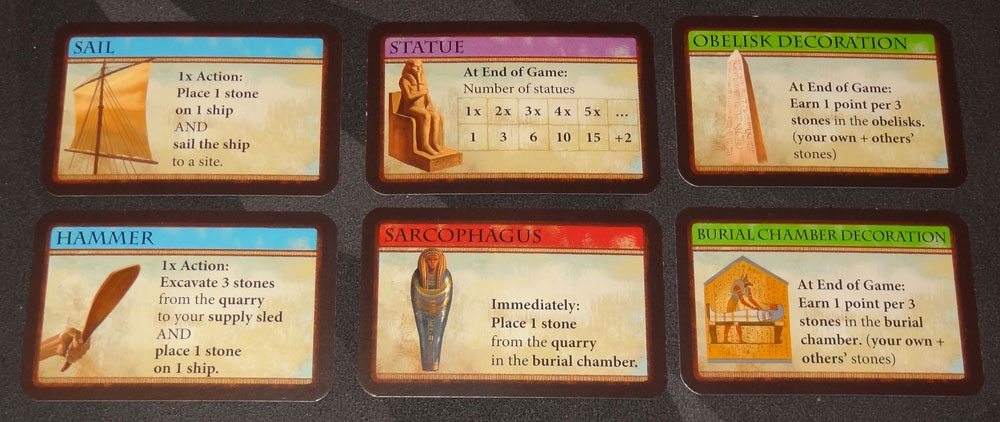
The market has four face-up cards—for each stone that you unload here (placing it back into the quarry), you get to take one of the cards. Blue cards may be played as your action for a turn, and usually give you more powerful actions, like placing a stone on a ship and sailing it immediately. Red cards give you an immediate action, often letting you bypass loading a stone and waiting for a ship to sail. Green cards will award end-game bonus points for stones on a particular site board, and purple statue cards give you an end-game set bonus depending on how many you collect.

The pyramid is built in three levels: 9 stones, then 4 stones, then 1 for the top. You place stones in a particular order, filling in columns from left to right, and each spot has an indicated point value, which is scored as soon as the stone is placed there. (For instance, the center stone of the base is worth more points than the surrounding spaces.) Once the pyramid is complete, any additional stones sent to the pyramid are worth 1 point each.
The temple is a wall: stones are unloaded from left to right, and when you run out of spaces, you start a new row, stacking the stones. At the end of the round, each stone visible from the top will score 1 point.
The obelisk board has one space for each of the four colors. Stones are placed in columns of the same color, regardless of the order on the boat. At the end of the game, players will score points based on the height of their obelisk; the tallest obelisk scores the most points, and the shortest obelisk scores the fewest.
The burial chamber is filled from left to right in columns as stones are unloaded. At the end of the game, you score points based on contiguous groups of stones—the larger the group, the more points you score.
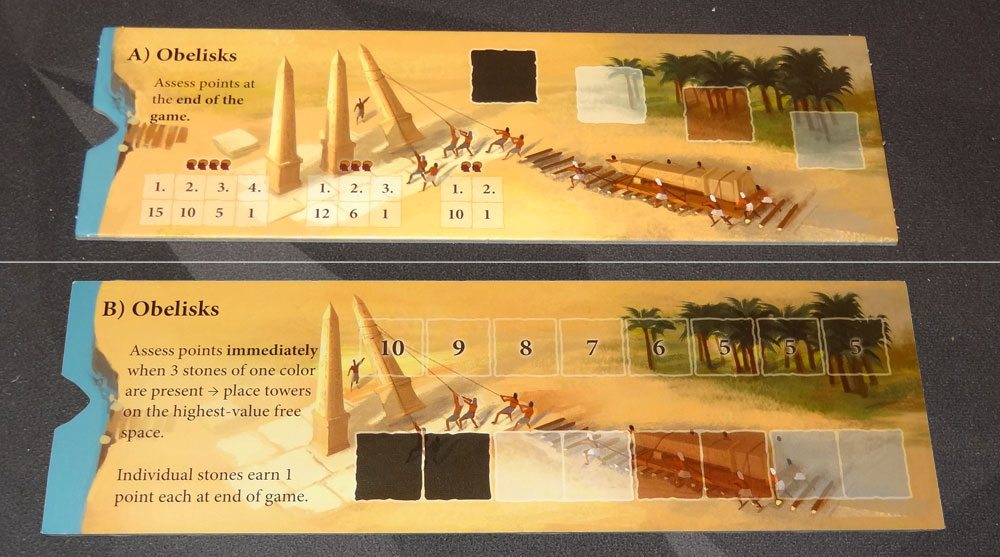
As noted above, each of the site boards has a “B” side as well, which allows you to mix up the game a bit and change the way the board works slightly. For instance, the obelisk “B” side looks a bit different: as you unload stones here, you place them onto the indicated color spaces, one stone per space. As soon as there are three stones of the same color, they are stacked onto the scoring spaces and score points immediately. The first obelisk built is worth 10 points, and the points decrease after that.
The Verdict
Imhotep was one of the 2016 nominees for the prestigious Spiel des Jahres, though it ultimately lost to Codenames. It’s easy to see why it made the short list, though: it is quite easy to learn, is suitable for a wide range of ages and experience levels, and it’s a lot of fun. The components are eye-catching, too.
I really like the level of player interaction, which can get quite cutthroat if you want it to. Since you’re limited to only one action per turn, it’s hard to get exactly what you want, so you really have to think about what other players may do and how they’ll respond to your actions. Most notably, you don’t always get to choose where the ships with your stones on them will go. That’s because players may launch ships even if there are none of their own stones on them. It’s an effective (and somewhat mean) way to shut down an opponent who may interfere with your plan: perhaps you see somebody amassing stones in an attempt to outbuild your obelisk—so you send those to the temple instead, where they build over their own stones and don’t net any points.
Since the ships can be sailed even when they’re not full, you never know exactly where in the order you will be until it actually sets sail. Maybe you’re angling for that center space on the pyramid base because it’s worth more points, so you put your stone in the second spot on the ship… but then your opponent launches it when the first space is empty. Of course, if you have any stones on a ship, you’re getting something no matter where the ship sails, so it’s usually not a total wash. But since the various boards score differently, position and placement make a crucial difference between scoring a few points and scoring big.
The other thing to note is that there are four ships each round but there are five site boards. So there’s always one board that will not get visited each round. If you thought you could hedge your bets by placing one stone on each boat, your opponents may thwart you anyway by sailing to every place but the one you really wanted.
Oh, and don’t underestimate the importance of getting more stones. Since you’re limited to five stones on your sled, eventually you have to go back to the quarry to get more—but when? Both visiting the quarry and sailing a ship mean that you didn’t get a chance to place a stone on a ship, so you have to weigh your options carefully.
The market cards can also be very powerful, though the trade-off is that you’re using stones to get cards rather than build anything. Statues are worth a lot of points if you get enough of them. Green “decoration” cards are nice because they award points based on the total number of stones on a site board, even if none of them are yours. The blue and red action cards are also great because it’s almost like getting an extra action, if you can pick the right time to use them.
The mix of immediate and end-game scoring means that it’s not always immediately obvious who’s really ahead without doing a lot of math. You can go for short-term points in the pyramids and the temple, or play the long game with the obelisk and burial chamber.
Overall, Imhotep is an excellent game that will especially please those players who are always stacking their resource cubes during other Eurogames. With the reversible boards, it has a lot of replay value. It’s easy to learn but still allows for a depth of strategy, and there will be a lot of player interaction (often accompanied by groans of dismay). Order a copy now, or look for it at your local game store.
Disclosure: GeekDad received a review copy of this game.
